 Long Eared Owls. This looks like a case from the Charles Stonham scientific collection and if so likely to have been mounted by Williams of Dublin.
Long Eared Owls. This looks like a case from the Charles Stonham scientific collection and if so likely to have been mounted by Williams of Dublin.
![PicD[1].JPG](PicD[1].JPG)
An example of the work of Edward Williams. This is a female Marsh Harrier. Given that the company ceased trading in 1941, this might be one of the last examples of this firms work
![PicC[1].JPG](PicC[1].JPG)
An example of the work of Edward Williams. This is a female Marsh Harrier. Given that the company ceased trading in 1941, this might be one of the last examples of this firms work
![PicB[2].JPG](PicB[2].JPG)
Typical data record from the above case.
![P1014453[1].JPG](P1014453[1].JPG)
Medal awarded to Williams for donations of live specimens to the Zoological Society of Ireland.
![P1014454[1].JPG](P1014454[1].JPG)
Medal awarded to Williams for donations of live specimens Zoological Society of Ireland.
![scan0015[1].JPG](scan0015[1].JPG)
A review by Brighton & Hove art society on the work of Alexander Williams.
![Irish Letter undated in 1903 bk[1].JPG](Irish Letter undated in 1903 bk[1].JPG)
Undated article on the work of Alexander Williams.
Alexander Williams RHA (1846-1930), one of the founders of the business, was my great uncle on my mother’s side; and at the present time I am trying to write something on Alex who, having combined taxidermy with singing and painting, became a painter full time. He left some 35 volumes of papers, including several volumes of memoirs, an Achill diary, a shooting diary started in 1867 (when he was twenty-one) letters, catalogue books of solo exhibitions, accounts and sketchbooks. There are two more ornithological diaries in the Ulster Museum.
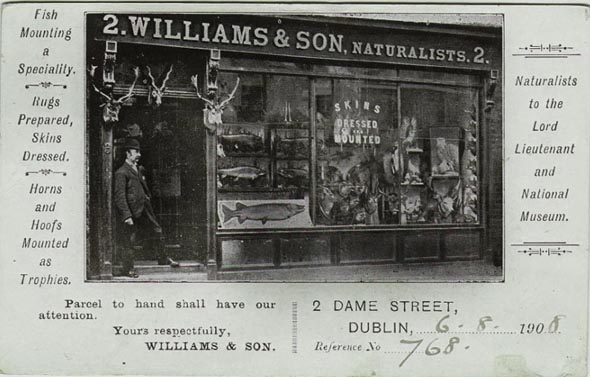
Wonderful postcard depicting the front of William's shop in Dublin dated 1908.
![E Williams [1].jpg](E Williams [1].jpg)
The person depicted standing in the doorway is in fact Edward Williams.
![Edward Williams Obituary_0002[1] [640x480].JPG](Edward Williams Obituary_0002[1] [640x480].JPG)
Edward Williams's obituary.
![williamstrout[1].jpg](williamstrout[1].jpg)
Williams Trout with data.
![williamstrout1[1].jpg](williamstrout1[1].jpg)
Williams Trout with data.
![williamstrout2[1].jpg](williamstrout2[1].jpg)
Williams Trout with data.
![willpike4[1].jpg](willpike4[1].jpg)
Williams Pike with data.
![willpike5[1].jpg](willpike5[1].jpg)
Williams Pike with data.
![willpike11[1].jpg](willpike11[1].jpg)
Williams Pike with data.
![Elk tiff[1].JPG](Elk tiff[1].JPG)
Edward Williams, with a reconstructed Irish Elk removed from a peat Bog.
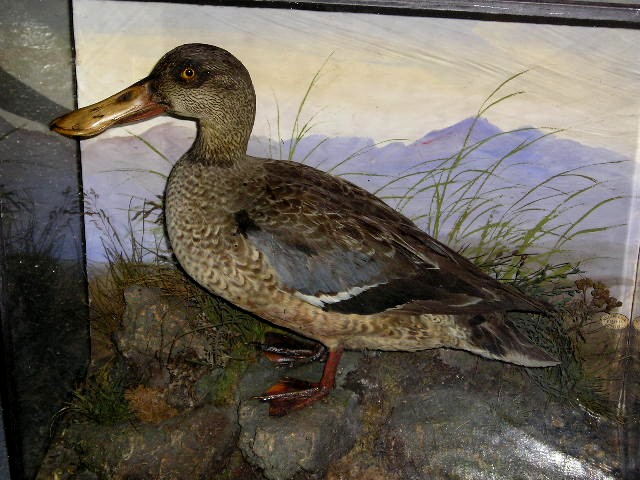 Female Shovelor duck by Williams of Dublin.
Female Shovelor duck by Williams of Dublin.

Additional postcard depicting the front of William's shop in Dublin dated 1907, showing a different array of natural history subjects.
Information provided by a relative of Alexander Williams
Alexander Williams RHA (1846-1930), one of the founders of the business, was my great uncle on my mother’s side; and at the present time I am trying to write something on Alex who, having combined taxidermy with singing and painting, became a painter full time. He left some 35 volumes of papers, including several volumes of memoirs, an Achill diary, a shooting diary started in 1867 (when he was twenty-one) letters, catalogue books of solo exhibitions, accounts and sketchbooks. There are two more ornithological diaries in the Ulster Museum.
Alexander was the eldest of three brothers, the youngest of which was my grandfather, Willie. After Alexander left the taxidermy business – after about eight years – it was run by his father, William; Edward, the middle brother and my grandfather. Edward died in middle age in 1905, thereafter my grandfather ran the business until his death in 1937. His elder son Teddy continued the business until he joined up during the Second World War, after which he joined Leicester Museum. The taxidermy business continued in a sort of fashion for some years after the war, when it was run by one of my grandfather’s workmen.
I can just remember as a small child being brought into the ‘studio’ at the top of what seemed like endless flights of stairs at the top of the building (since demolished) in Dame Street. I can remember vividly the overpowering smell of what was probably formaldehyde. There was a large skate hanging from the ceiling over a bucket. I was told it was a record catch. Otherwise, on a vast table that seemed to fill the room there were countless numbers of bird skins, and everywhere else too, on window ledges and all round the place, and an air of decay and dust. The abiding impression I have is that most of the specimens had not been touched in years. At the entrance to the studio was a plaster archway, on either side of which were a number of stuffed dogs.
This firm was founded by two brothers and was then joined by their father at a later stage. The postcard indicated above is dated 1908 and demonstrates the capability of the firm with the scale and diversity of the subject matter. Fish and birds were common, but more exotic animal preparations were also clearly undertaken as they are present in the image. We have made the assumption that the gentlemen pictured in the image is one of the Williams clan but which one, it is not possible to ascertain. We have been contacted by a member of the Williams family and have been informed that the person in the picture is likely to be William Williams.
Williams cases varied in design from domes, to flat fronted cases to all glass constructions. The quality of the work however is superb. We have seen many examples of fish by Williams of Dublin and also more interesting birds such as a female Marsh Harrier and a Shovelor duck (which appears to be in eclipse plumage). This case in particular has an interesting background; we have assumed that the landscape is perhaps where the bird was shot. Another case depicting English waders was recently sold at auction and sadly the contents of this case were dismantled and sold separately, perhaps for greater financial gain.
The message on the postcard states that a Peregrine Falcon was shot in a field in Silo on the 4th of August 1904 and sent to Mr Williams on the 5th of August 1904. We have no image of the result mount nor indeed any confirmation as to whether this mount was created for the client, a Mr G.W.Wood.
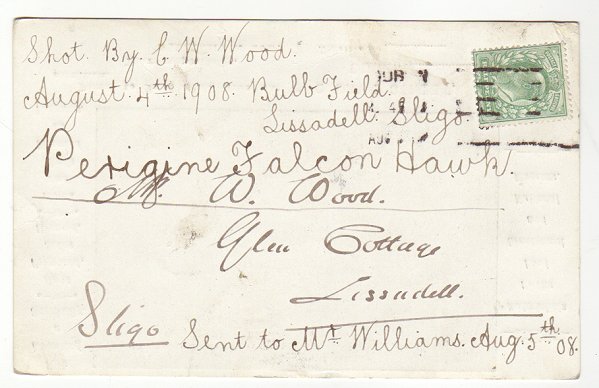
Wonderful postcard depicting the description of the bird that was sent to Williams & Sons 1908.
![brasswillplacue[1].JPG](brasswillplacue[1].JPG) Victorian label by William of Dublin.
Victorian label by William of Dublin.
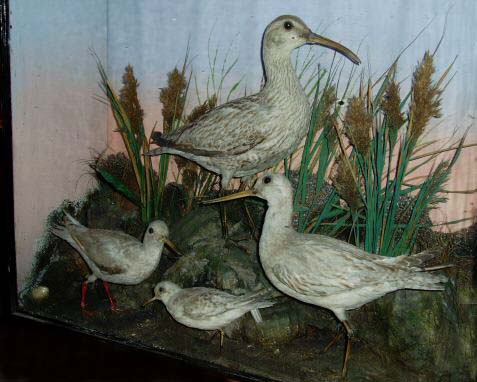
Case of Waders in winter plumage by Williams & Sons
![elephantsfootbywilliams[1].JPG](elephantsfootbywilliams[1].JPG)
African Elephant foot by Williams of Dublin

Label of the work of Williams of Dublin.
 of dublinpike.JPG) European Pike by Williams of Dublin.
European Pike by Williams of Dublin.
 Victorian label by Williams of Dublin.
Victorian label by Williams of Dublin.
The fish mounts we have had the opportunity to view have nearly always been mounted in flat fronted cases and more typically originate solely from fish that have been obtained in Ireland. This could be from visiting sportsmen to the region, who upon acquiring a fish that pleased them, had it mounted locally. Another reason is that fish "fade" quickly and therefore would not have travelled as well as other specimens.
It has also been reported that the last remaining brother / son of the taxidermy family moved from Ireland to Leicester and then finally to Norfolk where he continued, following his retirement from Leicester museum in 1969, until his death in 1977.
This ended almost 125 years of contribution to the art of taxidermy. It is interesting to note that although this firm in one form or another produced work for such a long period that very few items come onto the market for sale today. Should anyone have any further information and or indeed images to increase the knowledge of this firm then please contact us as we would be delighted to receive them.
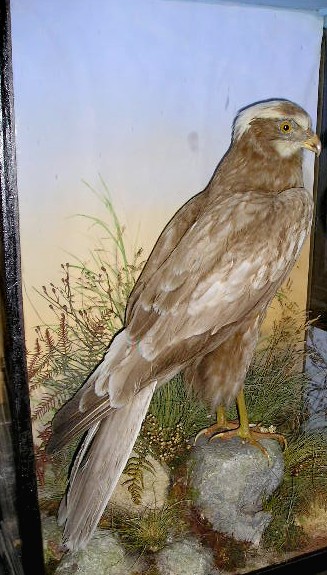 Female Marsh Harrier by Williams of Dublin.
Female Marsh Harrier by Williams of Dublin.
![wilsea1 [640x480].jpg](wilsea1 [640x480].jpg)
Seabirds by Williams of Dublin
![wilsea2 [640x480].jpg](wilsea2 [640x480].jpg)
Seabirds by Williams of Dublin
![wilsea3 [640x480].jpg](wilsea3 [640x480].jpg)
Seabirds by Williams of Dublin
![williamspike[1].jpg]( williamspike[1].jpg) European Pike by Williams of Dublin.
European Pike by Williams of Dublin.
James Sheals of Belfast
 European Kestrek by James Sheals.
European Kestrek by James Sheals.
Taxidermy4Cash does not undertaken taxidermy, rather we are collectors of
other people’s work, both current and historical we also offer web hosting,
a search engine submission service and increasingly one of the larger
article resource banks on the net. So if your keen to learn about Taxidermy
etc, then you know where to look.
We are always interested to here about new resource, if you feel a resource
should be listed here then please contact us.
|
ITEMS
WANTED. Please respond via this on-line form HERE
with a description of what you have for sale.
[HOMEPAGE]
Taxidermy Links.
Please double click on the Taxidermy link icon below.
Taxidermy
Links
|
|
![alexandhorseglenbrayheaddubbay[1].jpg](alexandhorseglenbrayheaddubbay[1].jpg)
![willcor99 [640x480].jpg](willcor99 [640x480].jpg)





![E Williams [1].jpg](E Williams [1].jpg)
![williamstrout[1].jpg](williamstrout[1].jpg)
![williamstrout1[1].jpg](williamstrout1[1].jpg)
![williamstrout2[1].jpg](williamstrout2[1].jpg)
![willpike4[1].jpg](willpike4[1].jpg)
![willpike5[1].jpg](willpike5[1].jpg)
![willpike11[1].jpg](willpike11[1].jpg)





![wilsea1 [640x480].jpg](wilsea1 [640x480].jpg)
![wilsea2 [640x480].jpg](wilsea2 [640x480].jpg)
![wilsea3 [640x480].jpg](wilsea3 [640x480].jpg)
![williamspike[1].jpg]( williamspike[1].jpg)
